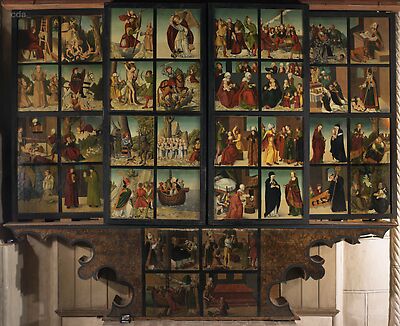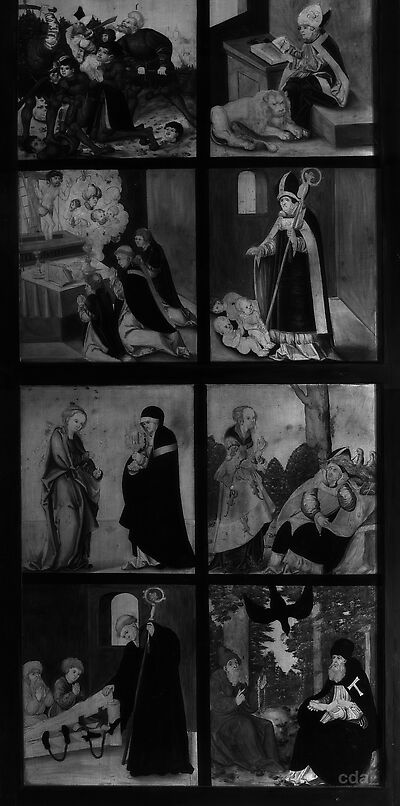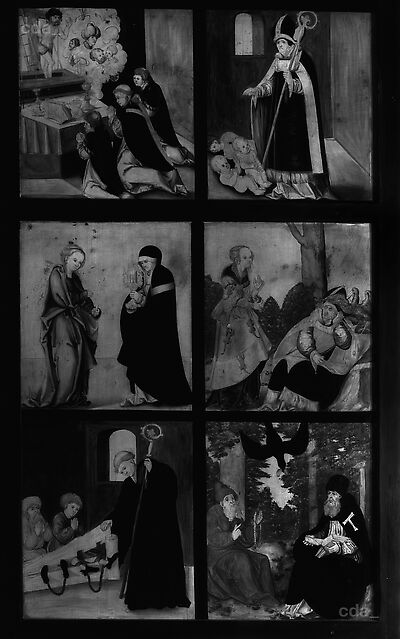Right side wing: The Martyrdom of the Theban Legion; The Mass of St Gregory; St Clare of Assisi and Genevieve; St Leonard freeing the Prisoners; The Evangelist Mark; a Bishop with Children; St Servatius of Tongeren; St Anthony visiting St Paul of Thebes.
First legend: Under their commander St Maurice
Right side wing: The Martyrdom of the Theban Legion; The Mass of St Gregory; St Clare of Assisi and Genevieve; St Leonard freeing the Prisoners; The Evangelist Mark; a Bishop with Children; St Servatius of Tongeren; St Anthony visiting St Paul of Thebes.
First legend: Under their commander St Maurice the Christian soldiers in the Theban Legion refused to sacrifice to the Emperor Maximian. Consequently at Agaunum on the Rhone (now Saint-Maurice) orders were given to have them beheaded. The panel depicts this bloodbath. Roman soldiers attack their Christian counterparts with swords, and although also armed the latter resign themselves to death and pray.
Second legend: A vision of Christ as the Man of Sorrows appeared to Pope Gregory and his two deacons while they were celebrating the Mass. He alighted from the tomb wearing the crown of thrones and displaying his stigmata. Behind him the tools of his Passion are visible: the cross, the ladder, the lance; the sponge and three nails. The three heads shown in a ring of cloud should also be read in this context: Judas with the money-bag around his neck, Herod wearing an oriental turban and Peter and the maid to whom he denied knowing Christ. The legend recounts that the pope and Church Father Gregory received a vision of Christ in the Church of Santa Croce in Gerusalemme in Rome. The motif aquired great significance and was widely disseminated, in particular as folkloristic evidence for the presence of the body of Christ in the Eucharist.
Third legend: St Clare is depicted as a nun wearing a black habit that conceals her neck and head. She holds a monstrance in her hands. She was the daughter of a noble family and became one of the first followers of St Francis. In 1212 as an eighteen year old she took her vows of poverty, chastity and obiedience. She founded a monastic female community the 'Second Order', which later became known as the Poor Clares. The precious monstrance in her hands is a late gothic piece worked in gold with decorative figures that reference an event in the saint¿s life. In about 1240 when plundering Saracens from Friedrich II's army threatened Assisi St Clare had herself brought to the gates of the monastery with the Holy Sacrament to ask for God's help. According to the legend the invaders who had already climbed over the monastery wall were so shocked that they beat a hasty retreat. The female saint standing opposite her, wearing modern secular clothes is probably Genevieve of Paris. Her attribute the candle has been misunderstood here. According to the legend she assisted against the 'Holy Fire' and on her way to church her candle was blown out by a devil and relit by an angel.
Fourth legend: Leonard was a Franconian nobleman, who supposedly lived at the court of the Merowingian king. The Golden Legend tells of his daily visits to the prisoners and recounts how he managed to convince King Chlodwig to liberate them. He turned down the diocese offered to him and instead chose to live as a hermit, curing cripples and helping the needy. Later he founded and became the abbot of Noblac monastery near Limoges. The panel depicts a young man with a tonsure already wearing a Benedictine habit and holding an abbatial staff. He opens the stocks himself to free the prisoners.
Fifth legend: Mark is depicted sitting at a lectern writing the gospel. As the bishop of Alexandria he wears a cope and mitre and as one of Peter's pupils he is represented as a young man. The lion, his symbol lies like a placid pet at his feet. The artist has created an image of a scholar in his small study similar to the many representations of St Jerome. This motif was particularly popular during the rise of humanism.
Sixth legend: Two small children are shown lying at the feet of a bishop who has raised his hand in blessing. A third child sleeps beside them, or perhaps he is also dead. The bishop who performed the miracle and is shown on the panel wearing vestments and holding a crosier cannot be clearly identified. It could be Valentine with the epileptic. He also cured a blind child, or Nicholas who raised three pickled boys from the dead.
Seventh legend: According to the legend an eagle protected Servatius, the bishop of Tongeren from the rays of the sun while he slept. The panel shows a sumptuously dressed young woman in front of the bishop with lizards climbing up her dress. She appeared to him in a dream and could be interpreted as the personification of heresy as Servatius contested the hererdoxy of the Arians, an act that was also equated with vanquishing the dragon.
Eighth legend: Paul of Thebes was the first Christian hermit. The son of rich parents he fled from Christian persecution into the mountains. There he spent his entire life in a cave without ever receiving anybody. However, shortly before his death he was visited by St Anthony, also a hermit, who lived first in a ruin on the Nile and then in the desert [...]. The panel shows Anthony wearing the habit of the order named after him exhibiting a T-shaped cross. The two old men are shown with rosary beads and a book lost in contemplation. The raven that supplied Paul in the desert brings them nourishment.
[Sachs 1989, 81, 111-113]
- Attributions
-
Follower of Lucas Cranach the Elder
Anonymous Master from the Cranach Workshop
Attributions
| Follower of Lucas Cranach the Elder | [Sachs 1989] |
| Anonymous Master from the Cranach Workshop | 'unknown, formal member of the Cranach Workshop' |
- Production date
- about 1515-1519
Production date
| about 1515-1519 | [cda 2017] |
- Dimensions
- Dimensions of upper support: 129.5 x 115 cm
Dimensions
Dimensions of upper support: 129.5 x 115 cm
Dimensions of lower support: 129 x 115 cm
[Heydenreich, cda 2016]
- Signature / Dating
None
- Owner
- St. Marien zu Bernau
- Repository
- St. Marien zu Bernau
- Location
- Bernau bei Berlin
- CDA ID
- DE_StMB_NONE-001f
- FR (1978) Nr.
- FR-none
- Persistent Link
- https://lucascranach.org/en/DE_StMB_NONE-001f/
![The Bernau Altarpiece [right side wing]: The Golden Legend (Aurea Legenda)](https://lucascranach.org/imageserver-2022/DE_StMB_NONE-001f_FR-none/01_Overall/DE_StMB_NONE-001f_FR-none_2016-02_Overall-s.jpg)
![The Bernau Altarpiece [left alteration wing]: Live of the Virgin [recto], Live of Saints [verso]](https://lucascranach.org/imageserver-2022/DE_StMB_NONE-001c_FR-none/01_Overall/DE_StMB_NONE-001c_FR-none_2016-02_Overall-s.jpg)
![The Bernau Altarpiece [right alteration wing]: The childhood of Christ [recto], Live of Saints [verso]](https://lucascranach.org/imageserver-2022/DE_StMB_NONE-001d_FR-none/01_Overall/DE_StMB_NONE-001d_FR-none_2016-02_Overall-s.jpg)
![The Bernau Altarpiece [left inner wing]: Passion of Christ [verso]](https://lucascranach.org/imageserver-2022/DE_StMB_NONE-001a_FR-none/01_Overall/DE_StMB_NONE-001a_FR-none_2016-02_Overall-s.jpg)
![The Bernau Altarpiece [right inner wing]: Passion of Christ [verso]](https://lucascranach.org/imageserver-2022/DE_StMB_NONE-001b_FR-none/01_Overall/DE_StMB_NONE-001b_FR-none_2016-02_Overall-s.jpg)
![The Bernau Altarpiece [left side wing]: The Golden Legend (Aurea Legenda)](https://lucascranach.org/imageserver-2022/DE_StMB_NONE-001e_FR-none/01_Overall/DE_StMB_NONE-001e_FR-none_2016-02_Overall-s.jpg)
![The Bernau Altarpiece [predella]: St Nicholas legend](https://lucascranach.org/imageserver-2022/DE_StMB_NONE-001g_FR-none/01_Overall/DE_StMB_NONE-001g_FR-none_2016-02_Overall-s.jpg)


